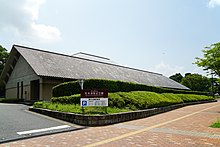Matsumoto Seicho
Matsumoto Seichō ( Japanese 松本 清 張 ; actually in Kun reading : Matsumoto Kiyoharu ; * December 21, 1909 in Kokura ; † August 4, 1992 in Tokyo ) was a Japanese writer . In addition to crime stories, in which he often explained the social problems that are the cause of crime, and which make up the majority of his literary work, he has also written historical novels and non-fiction. He wrote more than 450 works and was also called the "Japanese Simenon ".
Life
After elementary school, Matsumoto worked in a utility company. In his youth he read texts banned by the Japanese government out of political conviction. As an adult, he ended up designing covers for the Asahi Shimbun newspaper . After serving as a medic for two years during World War II - most of it in Korea - he returned to work for the Asahi.
In 1950 he took part in a literary competition run by the weekly Shūkan Asahi and took third place with a short story. In 1951 he made his debut with Saigō-satsu (Saigō banknotes). Several publications followed under his pseudonym Matsumoto Seichō . In 1952 he was awarded the Akutagawa Prize for Aru kokura nikki den , but it was not until 1956 that he gave up his post with the Asahi Shimbun in order to devote himself entirely to his literary career.
From then on, Matsumoto wrote up to seven books a year and made the detective story known in Japan. He has won several awards, including the 1956 Japanese crime writers ' award, the Kikuchi Kan Prize in 1970, and the Asahi Prize in 1990 .
In his works he also dealt with political issues by criticizing Japanese society, but also, for example, the United States. In 1968 he traveled to Cuba and North Vietnam . In the 1970s and 1980s he invested more and more time in writing non-fiction books, which were much more political than his criminal works. He died of cancer at the age of 82.
The director Nomura Yoshitarō filmed eight of his novels, including Suna no utsuwa (1974).
Suicides in the Aokigahara Forest
Main article: Aokigahara
Two books by Matsumoto are said to be the cause of the noticeably frequent choice of the Aokigahara as a place of suicide since the 1950s : on the one hand Nami no tō (Japanese 波 の 塔 ; dt. "The Wave Tower" or "Tower of the Waves"), on the other hand Kuroi jukai (Japanese 黒 い 樹 海 ; eng . "Black Sea of Trees"). Both deal with suicides in the Aokigahara Forest.
Works (selection)
- Aru kokura nikki den ( 或 る 「小 倉 日記」 伝 ), 1952
- Nami no tō ( 波 の 塔 ), 1957, German. The wave tower
- Ten to sen ( 点 と 線 ), 1958, German game with the timetable , Volk und Welt publishing house , Berlin, 1970
- Zero no shōten ( ゼ ロ の 焦点 ), 1959
- Kuroi jukai ( 黒 い 樹 海 ), 1960, German Black Sea of Trees
- Suna no utsuwa ( 砂 の 器 ), 1961
- Warui yatsura ( わ る い や つ ら ), 1961
- Kemo no michi ( け も の み ち ), 1963
- Chūō Ryūsa ( 中央 流沙 ), 1968
- Kurokawa no techō ( 黒 革 の 手 帖 ), 1980
- Meisō chizu ( 迷 走 地 図 ), 1983
- in German
- Amagigoe German "Mord am Amagi-Pass", translated by Heinz Haase and Barbara Sparing, Volk und Welt, Berlin, 1983
- Himo dt. "The nylon cord"
- Ichinen-han mate dt. "Only eighteen months"
- Kimyō-na hikoku dt. "I confess everything"
- Kuroi gashū German series title: "Black Pictures"
- Kyōki dt. "The murder weapon"
- Shōgen dt. "A witness statement"
- Sōnan dt. "The Accident"
- German "Manyō-Jade", translated by Peter Raff, OAG, 2004 online edition (PDF; 332 kB)
See also
Web links
- Biography and work analysis at Salem Press (English)
- Matsumoto Seichô Memorial Museum (Japanese) (English)
Individual evidence
- ↑ Peter Raff: Manyō-Jade by Matsumoto Seichō. (PDF; 332 kB) (No longer available online.) OAG , April 2004, p. 10 , archived from the original on April 19, 2012 ; Retrieved June 6, 2012 . Info: The archive link was inserted automatically and has not yet been checked. Please check the original and archive link according to the instructions and then remove this notice.
- ^ Francesca Di Marco: Suicide in Twentieth-Century Japan . Routledge, London (UK) 2016, ISBN 1317384288 , pages 119-121 & 129-131.
| personal data | |
|---|---|
| SURNAME | Matsumoto, Seicho |
| ALTERNATIVE NAMES | 松本 清 張 (Japanese); Matsumoto Kiyoharu (real name) |
| BRIEF DESCRIPTION | Japanese writer |
| DATE OF BIRTH | December 21, 1909 |
| PLACE OF BIRTH | Kokura |
| DATE OF DEATH | 4th August 1992 |
| Place of death | Tokyo |

